Main Spotlight: The LGBTQ+ Community’s Role in Economic Vitality
LGBTQ+ business owners, workers, and customers have a significant impact on local economies. Learn how your community can foster belonging to support more inclusive economic growth.

We work in collaboration with thousands of local partners and grassroots leaders across the nation who share our commitment to advancing shared prosperity, creating resilient economies, and improving quality of life.

Made up of small towns, mid-sized communities, and urban commercial districts, the thousands of organizations, individuals, volunteers, and local leaders that make up Main Street America™ represent the broad diversity that makes this country so unique.

Looking for strategies and tools to support you in your work? Delve into the Main Street Resource Center and explore a wide range of resources including our extensive Knowledge Hub, professional development opportunities, field service offerings, advocacy support, and more!

Your one-stop-shop for all the latest stories, news, events, and opportunities – including grants and funding programs – across Main Street.

Join us in our work to advance shared prosperity, create strong economies, and improve quality of life in downtowns and neighborhood commercial districts.
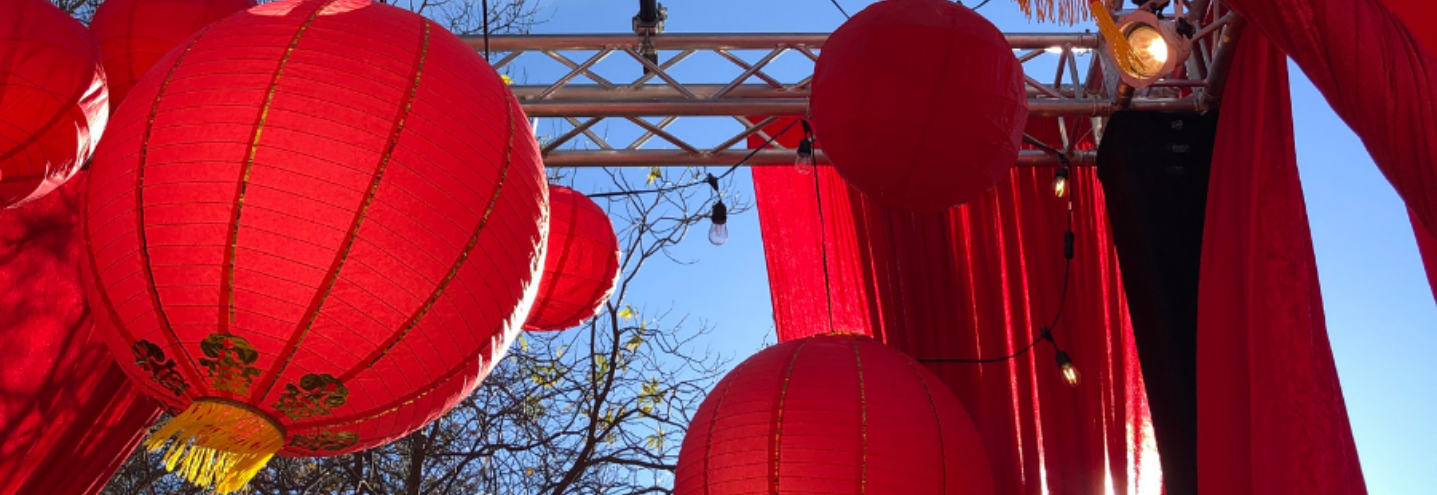
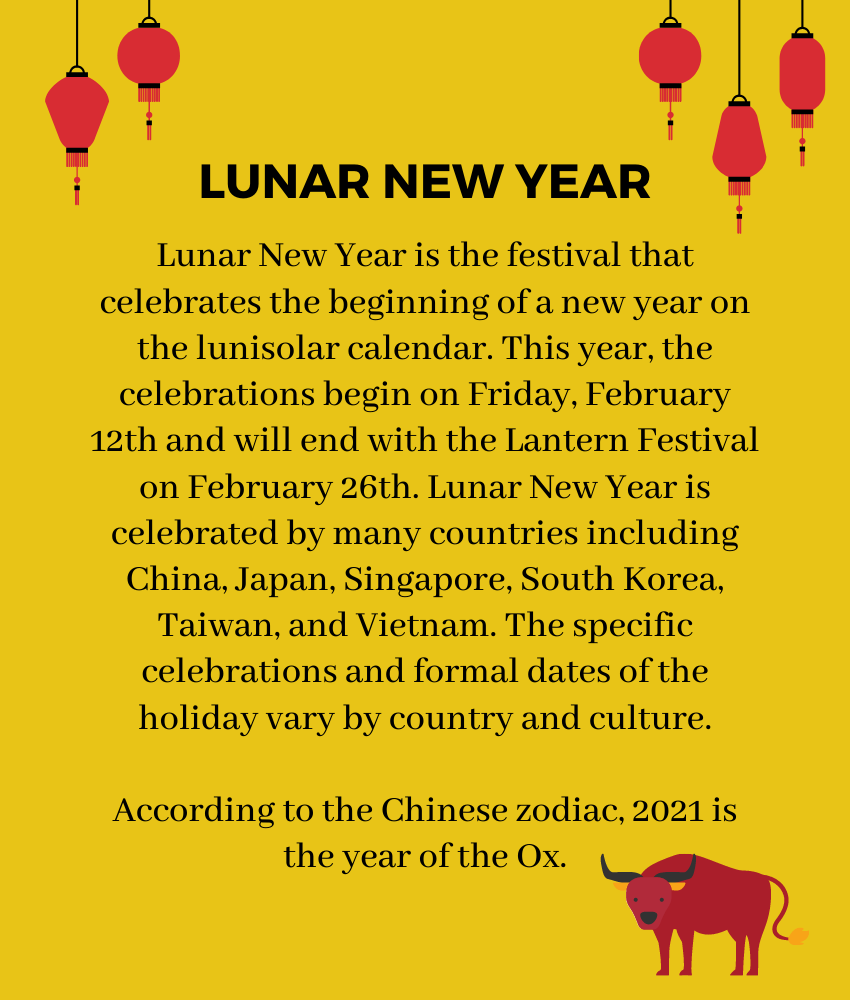
Downtown SLO has kept the magic of their holiday lights installation alive by evolving their winter wonderland into a dual celebration of Valentine’s Day and Lunar New Year, or Chinese New Year. The Light Up Downtown initiative began in late 2020, when this California Main Street program in San Luis Obispo transformed a permanent open street at the heart of downtown into a winter lights display. This passive activation of the plaza was complete with a twinkling Santa’s House, light-up snowflake selfie stations, and tinsel flamingo sculptures donning Santa hats. The event was a hit; so much so that at the end of the holiday season, the community wanted more.
“People weren’t ready for it to go back to being a beautiful but plain plaza,” said Bettina Swigger, Executive Director of Downtown SLO.
The Main Street program partnered with Karson Butler Events, a local women-owned events management company, to pivot Light Up Downtown into a celebration of Valentine’s Day and Lunar New Year. For Valentine’s Day, Downtown SLO is keeping the focus on supporting local with an installation called the Tunnel of Local Love: a glowing tunnel adorned with giant conversational hearts featuring messages such as “Local Love” and “SLO Strong.” In honor of Lunar New Year, red paper lanterns have been hung in the plaza, framed by draping red curtains and illuminated by lights.
“We wanted to have Valentine’s Day and Chinese New Year together as a way of saying ‘We all love our community and love each other, and we can take better care of where we’ve come from,’” said Swigger.
In the 1800s, Chinese settlers played a key role in developing a young San Luis Obispo. Whether they immigrated from China to escape hardships caused by the Taiping Rebellion or in pursuit of the riches from the California gold rush, Chinese immigration boomed in California in the mid-1850s. Conveniently located between San Francisco and Los Angeles (key points of entry from China to California), San Luis Obispo quickly became a hub for the Central California Chinese community. This hub was so popular that, by the 1870s, papers and local maps referred to a one-block area in San Luis Obispo as “Chinatown.”1
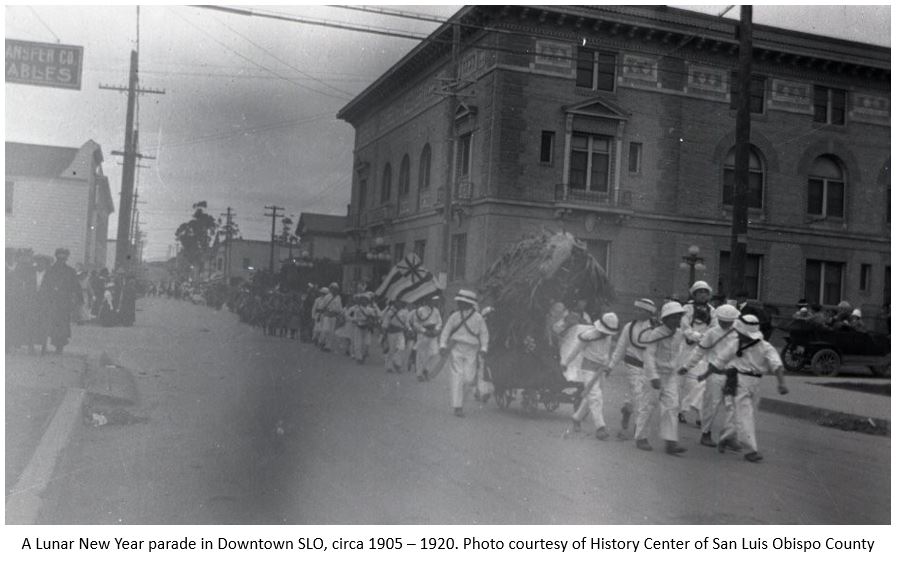
It was these Chinese pioneers that established the first brick kiln in San Luis Obispo county, built the Southern Pacific Railroad, and ran a host of small businesses in the downtown commercial district. A plaque in present-day Chinatown further details the impact of the Chinese community: “As immigrants they faced prejudice and exclusionary laws, but rose above such obstacles to make major contributions to local commerce, agriculture and industries.”2
One major figure in this community was Ah Louis (Ah-Lou-e-e). In 1870, Ah Louis arrived in San Luis Obispo after spending time in the goldfields of California and Oregon. Initially working as a cook at the French Hotel in San Luis Obispo, Ah Louis founded a store four years later that would fulfill a myriad of needs for the local Chinese community: a grocery and general merchandise store, employment office, bank, post office, and pharmacy. From this position, Ah Louis became one of the best-known Chinese merchants in SLO’s Chinatown and acted as the area’s unofficial mayor.3
Upgraded from a wooden structure to a brick building in 1886, Ah Louis’s store still stands in SLO’s Chinatown district today. In fact, the current tenants of the Ah Louis Store are Karson Butler Events, the event management company working with Downtown SLO to pivot the Light Up Downtown initiative into a Chinese New Year celebration.
When the goldrush waned and the big railroad projects were completed, jobs were becoming scarcer. Hostility towards the Chinese community rose from the white working class, who felt the Chinese immigrants were taking away their jobs. A series of discriminatory laws and actions—at the local, state, and federal level—targeted the Chinese community. Chinese-owned businesses left the commercial district, and families moved out of San Luis Obispo.4 As a result, the lifeblood of SLO’s Chinatown is no longer.
“There’s a forgotten history of downtown’s Chinatown,” said Swigger. “We have architectural pieces of that history that exist… but it’s place-only.”
Today, the community of San Luis Obispo can remember this part of their town’s history by strolling around the Lunar New Year installation. Serendipitously, the Light Up Downtown event is not the only recognition of SLO’s Chinese American history happening this year: a large mosaic mural installed in Chinatown is getting a face-lift.
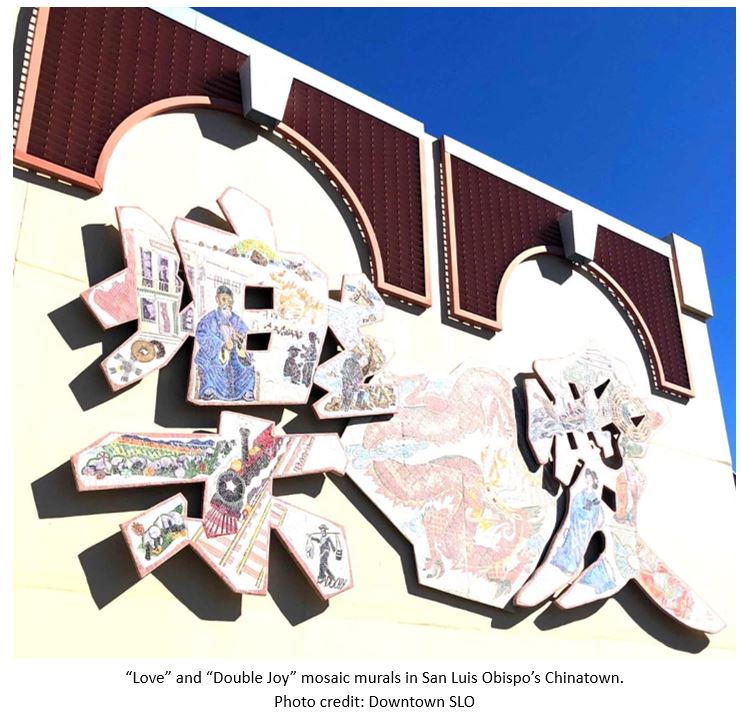
Installed in 1997, the last Year of the Ox, a giant mural of two Chinese characters—“Love” and “Double Joy”—was installed in commemoration of the City’s Chinese pioneers. According to the plaque commemorating the mosaic:
“The mural evokes images of Chinese-American history in San Luis Obispo County… The Chinese characters for “LOVE” and “DOUBLE JOY”, linked by a dragon, symbolize the duality of the immigrants’ experience: their love for the land of their birth and joy for their hopes in a new land. This message is still relevant to Chinese immigrants today.”5
Twenty-four years after its installation, the City is in the process of restoring the mural. Poetically, the work is scheduled to be wrapped up this year, the latest Year of the Ox.
While the mural is a beautiful nod to the impact of Chinese immigrants on San Luis Obispo’s history, Downtown SLO recognizes it can do a better job of honoring the legacy of Chinese Americans’ contributions to the town’s development.
“We need to make sure we’re not just forgetting a big part of the community that built our towns,” said Swigger. “Railroads were our highways and were built on the backs of a lot of Chinese immigrants.”
In the spirit of proactive intention setting, Downtown SLO placed a Wish Box in the plaza, where the community can draw or write their wishes for the new year. These wishes have been collected from January 1 through the beginning of the Chinese New Year. As of this writing, 85 wishes are displayed in Downtown SLO’s office window, a building two blocks away from Chinatown and all of its rich history.
As we enter the new year, may we all set the wish—the intention—to honor all the communities of people that built our towns. As Downtown SLO’s dual-holiday installation reminds us, let us remember that, “We love our community, we love each other, and we can take better care of where we came from.”
Downtown SLO thanks the City of San Luis Obispo for making the Light Up Downtown event possible. Learn more.
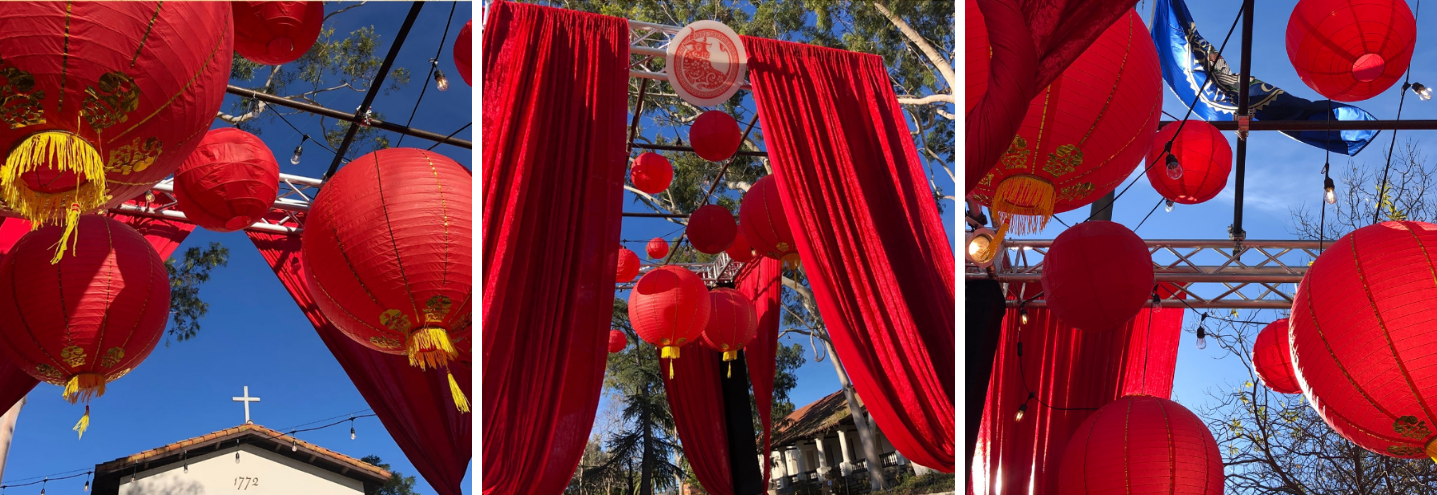
Photo credit: Downtown SLO
1. Parker, Dr. John. Archaeology of San Luis Obispo's Chinatown. http://www.wolfcreekarcheology.com/ChinaMain.html.
2. “‘Love’ and ‘Double Joy’ Historical Marker.” Historical Marker, June 16, 2016. https://www.hmdb.org/m.asp?m=52979.
3. HISTORY IN SAN LUIS OBISPO COUNTY Site created and maintained by Lynne Landwehr. https://www.historyinslocounty.org/Ah%20Louis%20Store.htm.
4. “The Chinese in 19th Century California - San Luis Obispo.” San Luis Obispo Railroad Museum. February 01, 2016. https://slorrm.com/2016/Notes_on_the_Chinese_2016-02-01.pdf.
5. “‘Love’ and ‘Double Joy’ Historical Marker.” Historical Marker, June 16, 2016. https://www.hmdb.org/m.asp?m=52979.